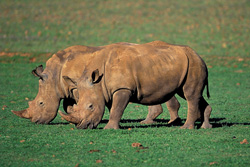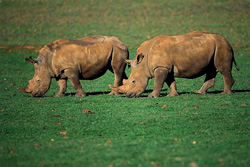Rhinoceros: An In-depth Overview of Habitat, Conservation Measures, Threats, and the Importance of Species Protection for These Majestic, Endangered Animals in South Africa
The white rhinoceros (Ceratotherium simum) is a remarkable species within the rhinoceros family, native to the expansive savannas and grasslands of South Africa. With an average body length of up to 4 meters and weighing as much as 2 tons, the white rhinoceros is distinguished by its prominent features such as the broad, two-lobed mouth, which allows it to graze on large quantities of grass. These animals are strict herbivores and play a crucial role in their ecosystems by controlling vegetation and aiding in seed dispersal.
Unfortunately, white rhinoceroses are critically endangered, primarily due to poaching for their highly coveted horns, which are mistakenly valued as medicinal remedies in East Asia, particularly in China and Vietnam. Despite numerous conservation efforts and the establishment of protected areas, there are only about 20,000 white rhinoceroses remaining worldwide. Conservation measures include strictly monitored reserves, anti-poaching units, and educational programs aimed at involving local communities in rhinoceros protection.
In addition to the white rhinoceros, there are four other highly endangered rhinoceros species: the Javan rhinoceros, the Black rhinoceros, the Sumatran rhinoceros, and the Nairobi rhinoceros. Each of these species faces unique challenges that must be addressed to ensure their long-term survival. Rhinoceros conservation is important not only from an ecological perspective but also culturally and economically, as they play a significant role in tourism and contribute to the diversity of biological resources.
White rhinoceroses are known for their social structure, often living in small herds led by a dominant male. They possess an acute hearing and sense of smell, which help them detect dangers early and communicate with fellow herd members. The reproduction of white rhinoceroses is also a key aspect of their lifecycle, with females giving birth to a single calf every two to four years, making population replenishment challenging.
Preserving the white rhinoceros requires international collaboration and comprehensive conservation strategies supported by governments, non-governmental organizations, and the global community. Initiatives such as combating illegal trade, promoting sustainable livelihoods in communities, and supporting research projects are essential to ensure the survival of these majestic animals.
Overall, the white rhinoceros stands as a symbol of wildlife conservation, whose protection and preservation are vital to maintaining biodiversity and allowing future generations to experience these impressive creatures in the wild.


